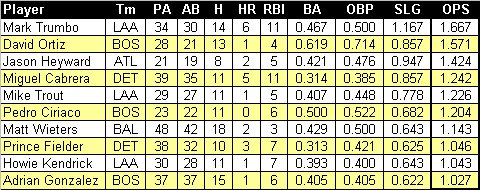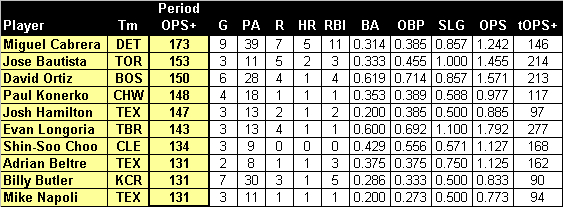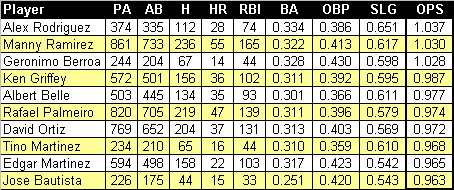
I really don’t know what to say about these Yankees anymore. Deep into the game I was sure this recap was going to be full of doom and gloom. I just knew they’d lose yet another, what would be their third loss in four games in Detroit, and somehow I’d have to put a positive spin on things and convince the Banter faithful that their faith would eventually be rewarded. It turned out none of that would be necessary, but we’ll get to that in a minute.
Doug Fister was on the mound for the Tigers. I’m not sure what the numbers are, but it seems like the Yankees tend to struggle against him. In the second inning, though, things were looking good. Eric Chávez sat on first base with two outs when Raúl Ibañez launched a towering fly ball over Quintin Berry’s head in deep left center field, far enough that even the slow-footed Chávez was able to score the game’s first run and the equally challenged Ibañez was able to cruise into third with a triple. Ichiro was up next, and he wasted no time in collecting his daily hit, flicking the second pitch he saw down the left field line for a stand-up double; the Yankees led 2-0.
I must admit that I didn’t have high hopes when Hiroki Kuroda joined the team during the off-season, but he’s quietly become the Yankees’ most dependable pitcher shorter than 6’6″ and weighing less than 290 pounds. Kuroda cruised through the first four innings, nursing that 2-0 lead but looking perfectly comfortable while doing so. Then came the fifth.
Jhonny Peralta hit a booming double to left to open the inning, and a few pitches later Alex Avila laced a home run down the line in right to tie the game at two. These things happen, I suppose, but what happened next usually doesn’t.
Ramón Santiago singled, and with two outs Andy Dirks floated a high fair/foul pop halfway down the line in left. Ibañez was on the case, though, and he hustled in from deep left hoping to make the final out. He came up short, but for a moment it didn’t seem to matter.
Just before the ball dropped, third base umpire Tim Welke threw his arms up, signifying a foul ball. The problem with that is that a split second later the fall ball fell on the chalk, forcing Welke to reverse his call and point correctly into fair territory. Ibañez chased the ball around long enough to allow Barry to score.
Manager Joe Girardi immediately popped out of the dugout and began debating with Welke. His point was that Welke’s initial call — even though it was incorrect — had caused Ibañez to give up on the play, if only for a moment. (For the record, replays did not seem to support this.)
Girardi could be seen to repeat his single claim over and over: “You called the ball foul!” Interestingly enough, Welke admitted as much early in their conversation, saying “I was too quick.” Sometimes an admission like that is enough for a manager, but it only seemed to throw kerosene on Girardi’s fire. He eventually convinced Welke to convene the other three umpires for a conference, but by that point I don’t think there was much that could’ve been done. Had Welke taken away Detroit’s run and pulled Barry back to third, Jim Leyland would probably still be arguing.
When the umpires inevitably held firm, Girardi lost control completely. Fans in the left field bleachers were probably reading his lips easily as he stabbed an index finger into his open palm to illustrate his point: “I’m protesting this game right now!” Welke made note of it and tried to walk away (perhaps because he knew it wasn’t a protestable situation), but Girardi had clearly made up his mind to get himself tossed.
It’s a funny thing. Ninety-nine percent of the time, my emotions run at a fairly even keel, and I almost never get angry. But when I’m coaching a basketball game and an official makes what I perceive to be a bad call and refuses to listen to my argument, everything changes in a Bruce Banner kind of way. If I were to list the ten angriest moments of my life, every single one of them would be the result of an official’s whistle. There’s a feeling that something has been unfairly taken from you in an irrevocable manner, and the feeling of injustice starts in your heart, courses through your veins, and eventually reaches your brain where it drives you insane.
I’ve been in that moment, and that’s where Girardi was on Thursday night. Welke eventually ejected him, but that hardly ended his tirade. He reiterated his protest, fired his hat in disgust, and appeared to make contact with crew chief Bob Davidson (suspension coming?). On his way to the dugout he pantomimed Welke’s error, throwing his hands up in the air, then pointing towards foul territory before pointing back fair. The whole episode lasted just a few seconds short of five minutes, and when Girardi finally turned towards the clubhouse, he paused on the steps long enough to hold his nose while looking in Welke’s direction. He didn’t get what he wanted, but at least he got his money’s worth.
Welke gave his take afterwards: “I started to put my hands up in the air — I was a little quick — then I saw the ball hit the chalk line, and I pointed fair about three times,” Welke said. “I don’t think it had any impact. I’ve watched the replay, and I don’t think there was any impact on the outfielder. I don’t think Ibanez ever even saw me. We got the call right.”
It looked for a while like that was going to be the story of this game. Another creatively painful way for the Yankees to lose.
But in the eighth Mark Teixeira jumped on a 2-0 pitch from reliever Joaquin Benoit and ripped a line drive home run into the stands in right, tying the score at three. Before Benoit could think much about that, Chávez took the very next pitch and lofted a home run of his own over the left field wall, and suddenly the Yankees had the lead again.
Rafael Soriano got the last out of the eighth for the Yanks, then almost threw everything away in the ninth, and it took only three pitches. He gave up a double to Avila to lead things off, then yielded a short single to Omar Infante to put runners on the corners with no one out.
The Yankees surely were hoping to preserve a tie and would’ve been happy just to get to the tenth inning, but somehow Soriano did better than that. He got Santiago to float a soft liner to Canó at second for the first out, induced a pop-up from Berry, then nailed down the third out when Dirks hit a weak fly ball to center. Yankees 4, Tigers 3.
There are questions in Yankeeland, but for one afternoon at least, the answers were adequate.
[Photo Credit: Duane Burleson/AP Photo]






























